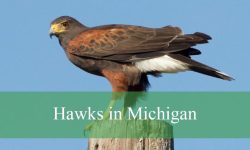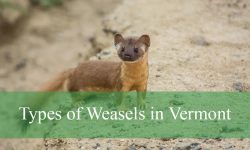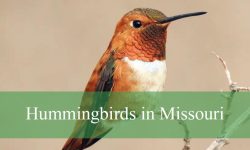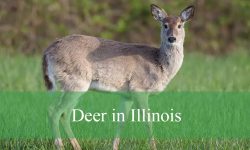Indiana is home to a wide variety of insects, many of which play vital roles in nature—but some can bite, sting, or spread disease. From venomous spiders to blood-feeding ticks and aggressive wasps, these bugs can pose real risks if not properly identified.
While most encounters are harmless, knowing which species to watch out for can prevent painful stings, allergic reactions, or infections. Some insects, like the Brown Recluse Spider or Deer Tick, require extra caution due to their venom or disease-carrying potential.
This guide highlights 22 dangerous bugs found in Indiana, complete with pictures and identification details. Understanding their appearance, habits, and habitats will help you stay safe whether you’re hiking in the woods or relaxing in your backyard.
Types of Dangerous Bugs Found in Indiana
Brown Recluse Spider (Loxosceles reclusa)
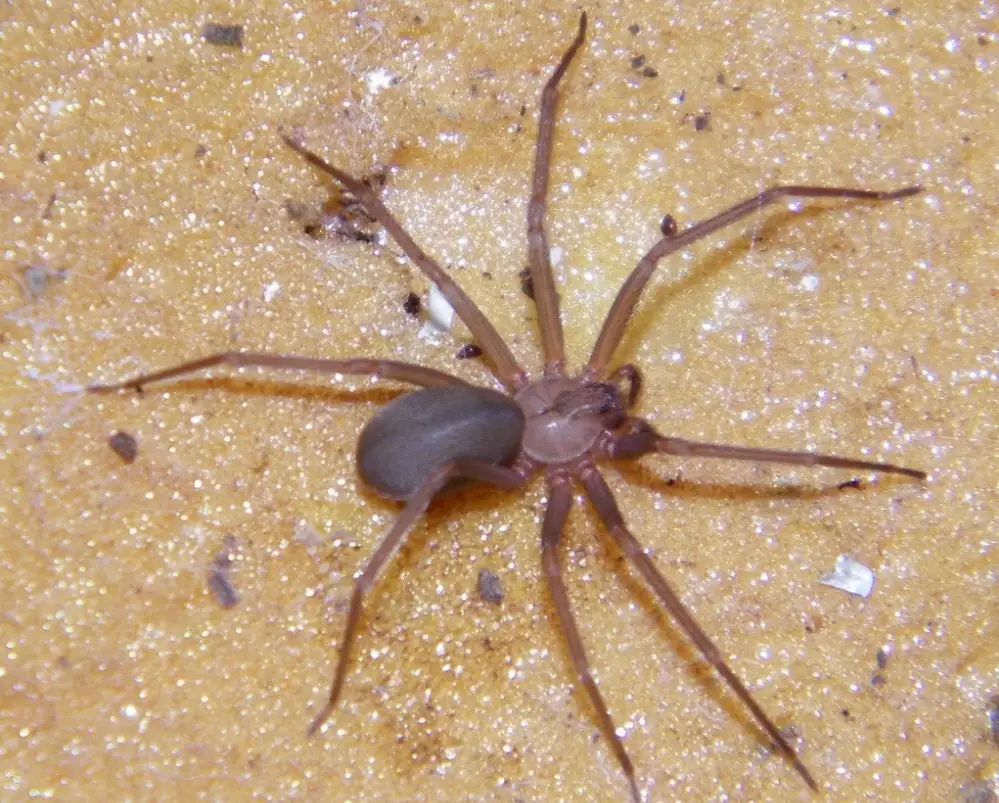
The Brown Recluse Spider is one of Indiana’s most recognized and feared arachnids. It has a light to dark brown body, with a distinctive dark violin-shaped marking on its back. This spider measures about 0.25 to 0.75 inches in body length, with long, thin legs giving it a delicate appearance. Unlike many other spiders, it has only six eyes arranged in pairs, which helps in identification.
Brown Recluse Spiders prefer dark, undisturbed places such as basements, attics, closets, and woodpiles. They are mostly nocturnal and come out at night to hunt small insects. During the day, they stay hidden in crevices or under furniture, showing their reclusive nature that inspired their name.
Their venom contains necrotic toxins that can cause significant tissue damage in humans. A bite may initially feel painless but later develop into a red, blistered area that can turn into an open ulcer. Medical attention is recommended immediately after a suspected bite.
In Indiana, encounters with Brown Recluse Spiders are relatively rare but should be treated seriously. Regular cleaning, sealing wall cracks, and reducing clutter can greatly minimize risks. Despite their venomous nature, these spiders are not aggressive and only bite when accidentally pressed or provoked.
Black Widow Spider (Latrodectus mactans)
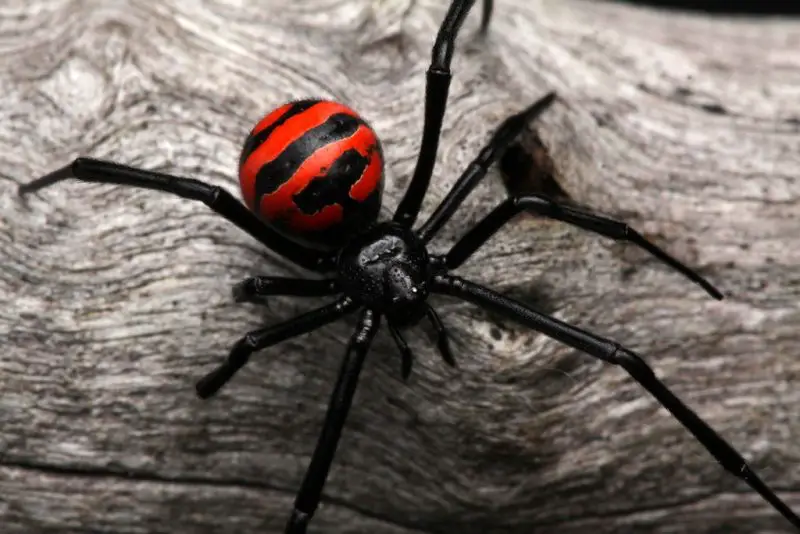
The Black Widow Spider is easily identified by its glossy black body and the iconic red hourglass marking on the underside of its abdomen. Females are about 1.5 inches across including their leg span, while males are smaller and less venomous. Their smooth, rounded bodies and shiny appearance make them stand out among other spiders found in Indiana.
Black Widows build irregular, tangled webs in dark, quiet areas like woodpiles, sheds, garages, or beneath rocks. They prefer secluded spots and rarely move far from their webs. Their webs are made of strong silk used to trap insects and small arthropods for food.
Their venom is potent and acts on the nervous system, sometimes causing muscle cramps, nausea, and sweating. Although painful and alarming, bites are rarely fatal, especially with prompt medical care. Only the female poses a significant danger to humans, as males seldom bite.
In Indiana, the Black Widow is not common but can be found in the southern and central parts of the state. People working outdoors or handling firewood should exercise caution. Wearing gloves and checking hidden corners can help prevent accidental encounters.
Deer Tick (Ixodes scapularis)
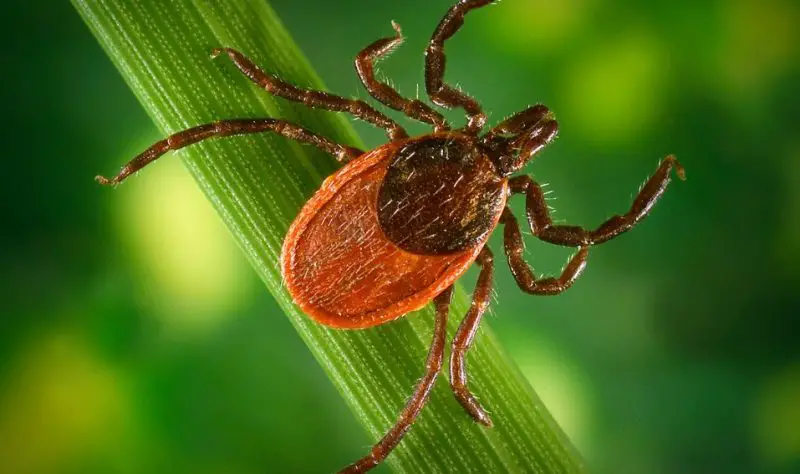
The Deer Tick, also known as the Blacklegged Tick, is a small parasitic arachnid with a reddish-brown body and black legs. Adult females are about 3 millimeters long, while males are slightly smaller. When engorged with blood, their bodies can swell significantly, turning a lighter grayish color.
These ticks are common in wooded and grassy areas of Indiana, particularly where deer populations are high. They cling to vegetation and wait for mammals, birds, or humans to brush past so they can attach and feed. Their lifecycle includes four stages: egg, larva, nymph, and adult.
Deer Ticks are medically significant because they can transmit Lyme disease, caused by the bacterium Borrelia burgdorferi. Symptoms include fever, fatigue, and a bullseye-shaped rash. Quick removal of ticks within 24 hours greatly reduces the risk of infection.
People in Indiana who hike, garden, or spend time outdoors should take preventive measures such as using insect repellents, wearing long sleeves, and checking their bodies after exposure to vegetation. Deer Tick bites are painless, making regular self-inspection essential.
Dog Tick (Dermacentor variabilis)
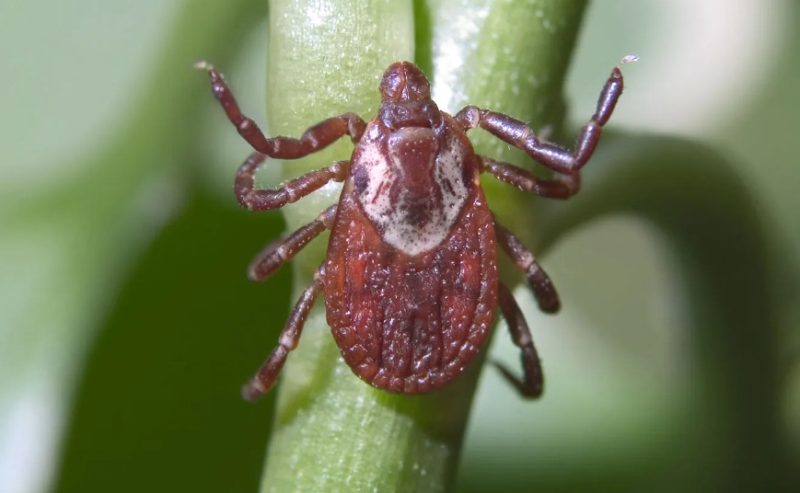
The Dog Tick, also called the American Dog Tick, is one of the most widespread ticks in Indiana. Adults are brown with grayish-white mottled patterns on their backs, making them easy to distinguish from other species. Females grow to about 5 millimeters before feeding but can swell several times larger when engorged with blood.
Dog Ticks are typically found in grassy fields, along trails, and in areas frequented by domestic animals. They attach to mammals like dogs, raccoons, and humans, feeding for several days before dropping off to continue their life cycle. They are more active in spring and early summer.
While Dog Ticks do not transmit Lyme disease, they can carry Rocky Mountain spotted fever and tularemia, both of which can be serious if untreated. Symptoms of infection include fever, rash, and muscle pain. Prompt removal of the tick and medical evaluation are important.
In Indiana, pet owners should regularly check their animals for ticks after outdoor activity. Keeping lawns trimmed and using veterinarian-approved tick prevention treatments can help reduce infestations. Though bites can be irritating, Dog Ticks are not naturally aggressive toward humans.
Lone Star Tick (Amblyomma americanum)
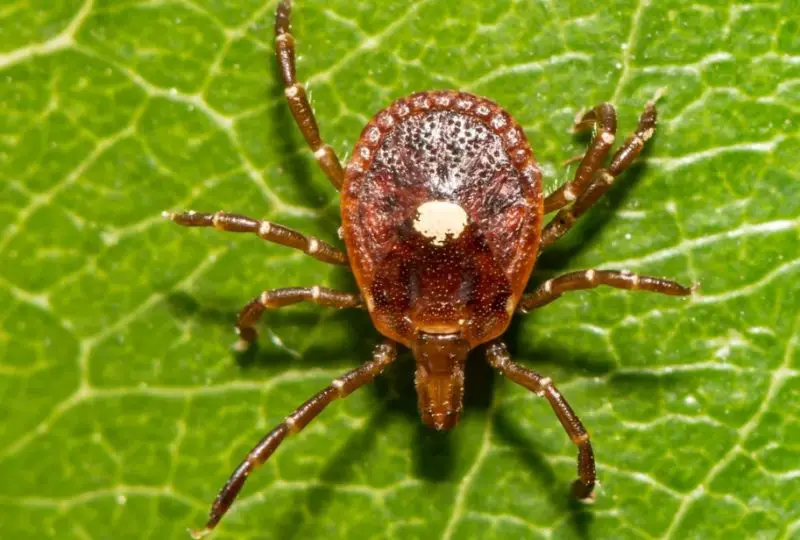
The Lone Star Tick is named for the single white spot found on the female’s reddish-brown back. Males are smaller and have scattered white markings rather than a central dot. Adults are about 3 to 4 millimeters long but expand dramatically after feeding. Their bodies are oval and slightly flattened, typical of most ticks.
This species prefers warm, humid environments and is common in southern Indiana, often found in woodlands and areas with thick underbrush. Lone Star Ticks are very active and will actively move toward potential hosts, unlike many ticks that wait passively.
Their bite can cause intense itching and irritation, and they are capable of transmitting diseases such as ehrlichiosis and tularemia. Additionally, bites from Lone Star Ticks have been linked to “alpha-gal syndrome,” a condition causing red meat allergies in humans.
To stay safe in Indiana, avoid sitting directly on grass and use tick repellents when outdoors. Wearing light-colored clothing makes it easier to spot these ticks. While their bite is not typically painful, the allergic reactions they can induce make them one of the more concerning tick species in the region.
Mosquito (Culex and Aedes species)
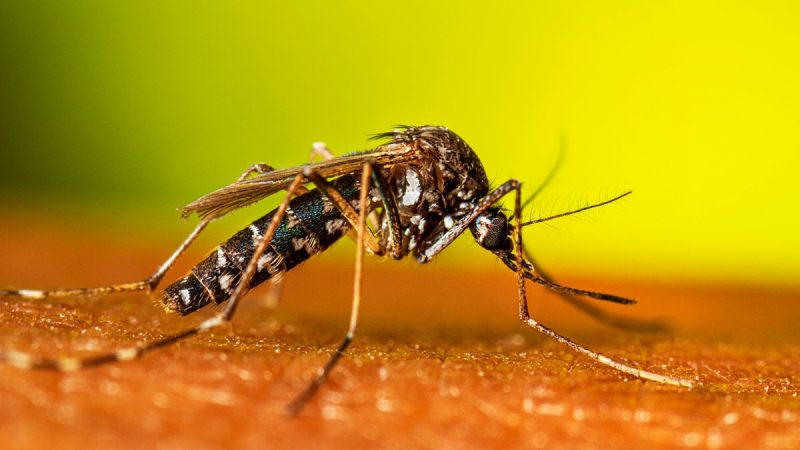
Mosquitoes from the Culex and Aedes genera are among the most common biting insects in Indiana. These small, slender-bodied insects have long legs, a pair of delicate wings, and a distinctive long proboscis used for piercing skin and drawing blood. Aedes mosquitoes, such as the Asian tiger mosquito, are easily recognized by their black-and-white striped bodies and legs.
Mosquitoes thrive in warm, humid environments and breed in stagnant water sources like puddles, birdbaths, and buckets. Culex species are usually most active at dusk and dawn, while Aedes mosquitoes tend to bite during the daytime. Both types are drawn to carbon dioxide, body heat, and sweat emitted by humans and animals.
While mosquito bites cause mild itching and swelling for most people, they can also transmit serious diseases. Culex mosquitoes are known carriers of West Nile virus, while Aedes species can spread Zika and dengue fever, though these are rare in Indiana. Still, they remain a significant nuisance during summer months.
To minimize risk, residents should remove standing water around homes, use insect repellents containing DEET or picaridin, and install window screens. Wearing long sleeves and pants outdoors during peak activity hours helps reduce bites. Mosquitoes are not just pests—they are one of Indiana’s most persistent seasonal health concerns.
Yellowjacket Wasp (Vespula species)
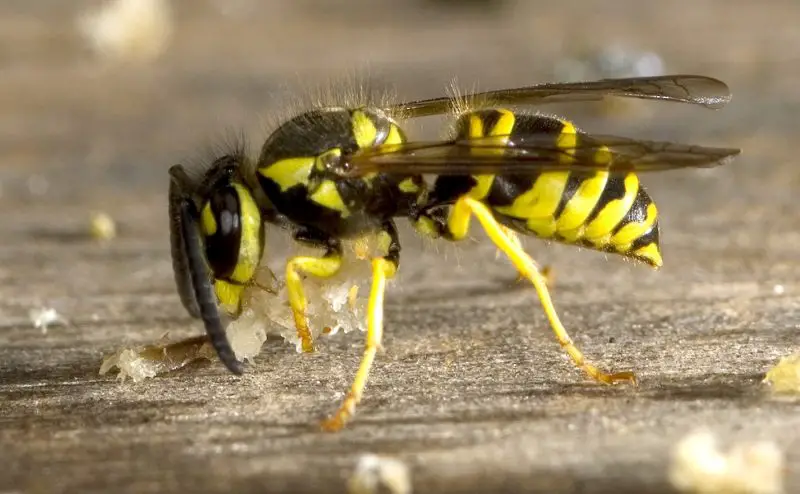
Yellowjackets are compact, bright yellow and black wasps with shiny bodies and strong, fast-flying movements. Measuring about 0.5 inches long, they are often mistaken for bees but lack the dense hair and have a more defined waist. These aggressive insects are easily recognized by their vivid coloration and buzzing flight patterns around food and garbage.
In Indiana, Yellowjackets build paper-like nests in the ground, wall cavities, or tree hollows. Colonies can grow to thousands of individuals by late summer. They feed on sugary substances such as fruit and nectar, but they also scavenge protein from dead insects or human food, which brings them close to outdoor gatherings.
Their sting is painful and can cause swelling, redness, and intense burning. Unlike bees, Yellowjackets can sting multiple times without dying. For individuals allergic to wasp venom, stings can trigger severe anaphylactic reactions requiring immediate medical care.
Yellowjackets are beneficial for controlling other insect populations, but they pose a danger when disturbed. In Indiana, removing nests should be done at night by professionals. Keeping trash bins sealed and avoiding floral perfumes outdoors can help reduce unwanted encounters.
Bald-Faced Hornet (Dolichovespula maculata)
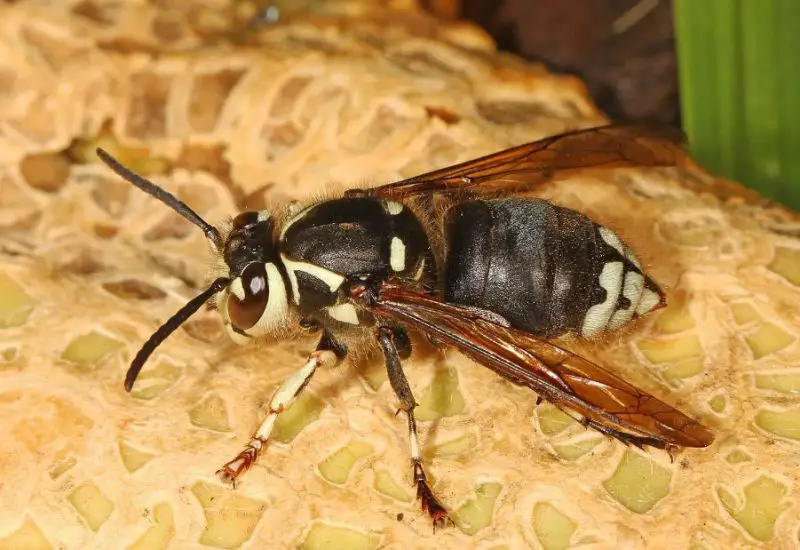
The Bald-Faced Hornet, despite its name, is not a true hornet but a large species of wasp native to Indiana. It is strikingly marked with black and white patterns, especially on its face, and measures between 0.75 to 1 inch in length. Its robust body and loud buzzing make it one of the more intimidating insects to encounter.
These hornets build large, gray, paper-like nests that hang from trees, bushes, or buildings. The nests can reach the size of a basketball by late summer, housing hundreds of workers. Bald-Faced Hornets are social insects that defend their colonies aggressively if threatened, often attacking in swarms.
Their sting is extremely painful and can cause welts or localized swelling. Unlike honeybees, they can sting repeatedly. While not venomous enough to kill a healthy adult, multiple stings or allergic reactions can be dangerous and require medical attention.
In Indiana, Bald-Faced Hornets play an important role in controlling flies and other pests. However, their defensive behavior makes them a hazard near homes or parks. It’s best to avoid their nests and contact pest control professionals for safe removal.
Paper Wasp (Polistes species)
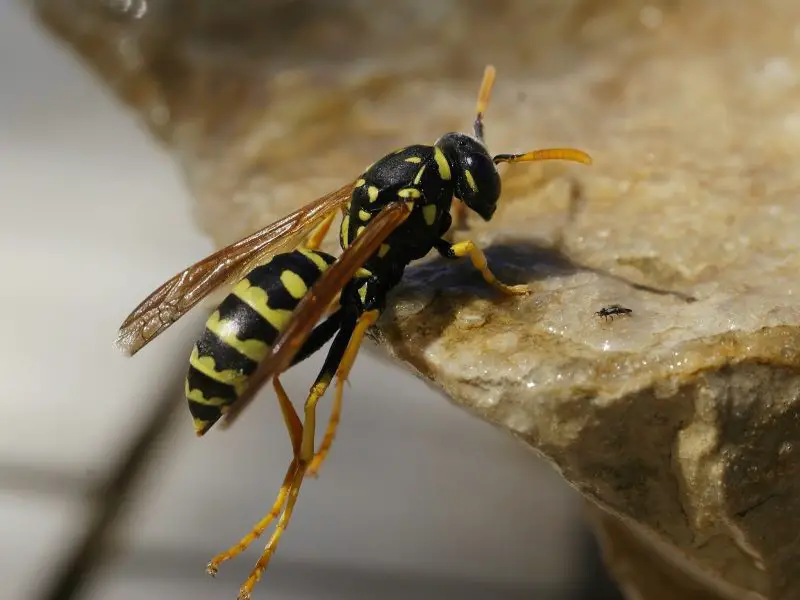
Paper Wasps are slender, long-legged wasps typically colored brown or black with yellow or reddish markings. Measuring around 0.7 to 1 inch in length, they are less stocky than hornets or yellowjackets and can be identified by their distinct, umbrella-shaped nests made of papery material.
These wasps build their open-celled nests under eaves, in attics, or on porch ceilings across Indiana. Colonies are smaller than those of hornets, usually containing fewer than 100 individuals. Paper Wasps are generally non-aggressive but will sting defensively if their nest is disturbed.
Their sting is sharp and causes temporary pain, redness, and swelling. While not deadly, their venom can trigger allergic reactions in sensitive individuals. They do not repeatedly sting unless provoked, making them less dangerous than some of their relatives.
Paper Wasps are beneficial pollinators and help control caterpillars and other garden pests. In Indiana, it’s advisable to observe them from a distance and remove nests only when necessary. Maintaining screens and sealing cracks near roofs helps prevent them from nesting indoors.
European Hornet (Vespa crabro)
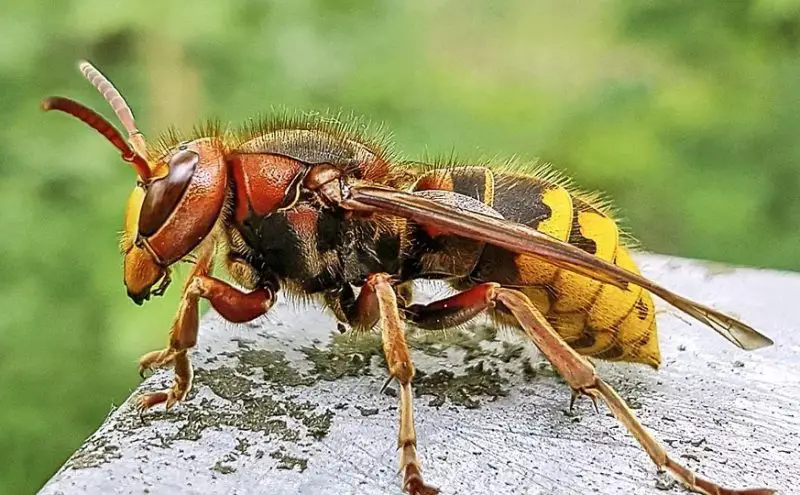
The European Hornet is the largest wasp species in Indiana, reaching up to 1.5 inches in length. It has a reddish-brown head and thorax with yellow and black bands on the abdomen. Despite its intimidating size, it is less aggressive than many smaller wasps, unless its nest is directly threatened.
European Hornets prefer wooded areas, but they often build nests inside hollow trees, attics, or wall voids. Their nests, made of coarse paper, can hold hundreds of individuals by late summer. They are mostly active during the day and are attracted to lights at night, sometimes entering homes through open windows.
Their sting is painful and can cause swelling and redness similar to that of a Yellowjacket. Multiple stings or allergic reactions can be dangerous, but they generally avoid humans when undisturbed. The venom is not lethal but should be taken seriously if symptoms persist.
In Indiana, European Hornets help control large insects like grasshoppers and moths, making them beneficial in ecosystems. However, due to their size and defensive behavior, homeowners should avoid disturbing nests. Proper maintenance and nighttime precautions can help prevent unwanted hornet activity near homes.
Carpenter Bee (Xylocopa virginica)
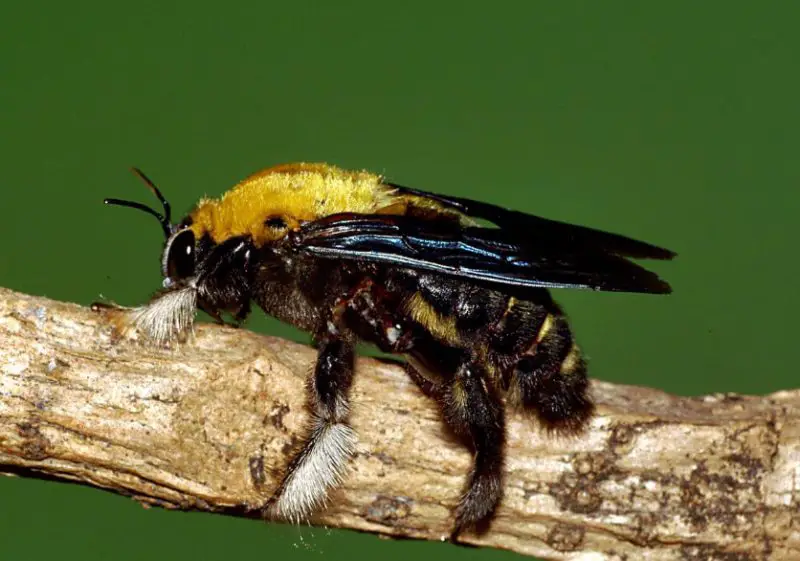
The Carpenter Bee is a large, robust bee that closely resembles a bumblebee but can be distinguished by its shiny, hairless black abdomen. Measuring about 0.75 to 1 inch long, it has a fuzzy yellow thorax and a loud buzzing flight pattern. Males are often curious and hover near people but lack stingers, while females can sting if provoked.
These bees are common across Indiana and prefer nesting in untreated or weathered wood, such as decks, fences, and porch rails. Instead of eating wood, they bore smooth, round holes to create tunnels for laying eggs. Over time, these nesting activities can weaken wooden structures if infestations grow.
Carpenter Bees are solitary and not aggressive by nature. Their sting is mild but can cause pain, redness, and swelling. They rarely sting unless handled directly. Their buzzing and wood-drilling behavior are often the main nuisances for homeowners.
Despite being considered pests, Carpenter Bees are vital pollinators of many native plants and gardens in Indiana. To prevent nesting, painting or sealing exposed wood is effective. Non-lethal traps can also be used to deter them without harming the ecosystem.
Assassin Bug / Kissing Bug (Triatoma sanguisuga)
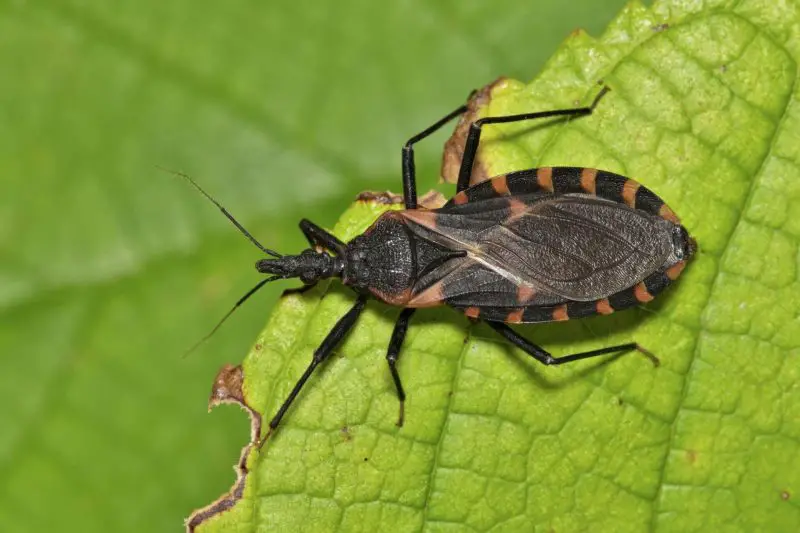
The Assassin Bug, also known as the Kissing Bug, is a predatory insect known for its elongated body, narrow head, and curved beak used for piercing prey. Adults measure about 0.75 to 1.25 inches long and are usually dark brown or black with orange or red edges along the abdomen. They are nocturnal and capable of flying.
These bugs are found across Indiana, particularly in rural and wooded areas, where they feed on other insects like beetles and caterpillars. However, some species are attracted to homes, especially during summer nights, when they may bite humans while seeking blood meals.
Their bite is typically painful and causes localized swelling and itching. Although Triatoma sanguisuga can carry the parasite that causes Chagas disease in other regions, transmission in Indiana is extremely rare. Most bites occur when the insect accidentally lands on sleeping humans or pets.
To avoid encounters, seal cracks around doors and windows, and reduce outdoor lighting that attracts insects. Assassin Bugs are generally beneficial to ecosystems as natural pest controllers, but direct contact should be avoided due to their strong piercing bite.
Blister Beetle (Epicauta species)
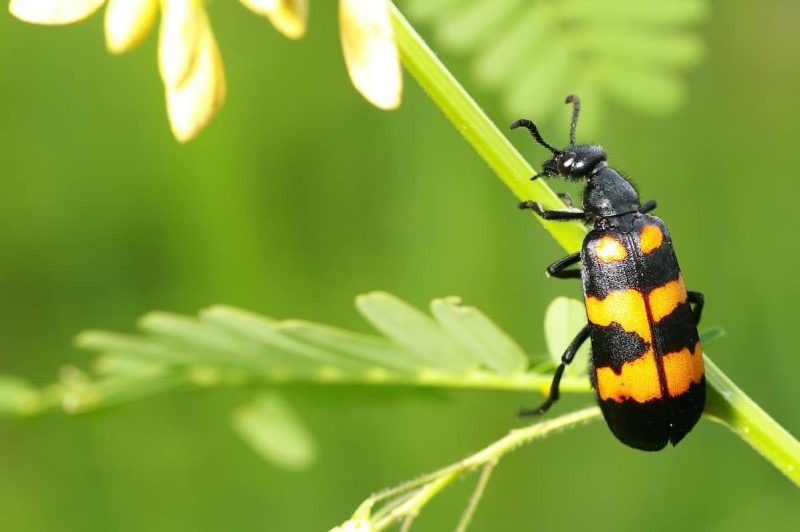
Blister Beetles are slender insects with soft bodies that can range from 0.5 to 1 inch long. They come in various colors, including black, gray, and striped patterns, depending on the species. Their elongated shape and flexible wing covers distinguish them from other beetles commonly seen in Indiana.
These beetles are often found in gardens, fields, and areas with flowering plants, especially in midsummer. Adults feed on crops like alfalfa, tomatoes, and potatoes, while larvae prey on grasshopper eggs, making them both agricultural pests and natural regulators.
Blister Beetles contain a toxic chemical called cantharidin, which can cause skin irritation or blistering upon contact. When crushed or handled carelessly, the toxin can burn human skin or harm livestock that consumes contaminated forage.
In Indiana, the best prevention is to wear gloves when working in fields or handling plants. Avoid direct contact and wash skin immediately if exposure occurs. While not aggressive, their chemical defense mechanism makes them one of the more hazardous insects to encounter outdoors.
Japanese Beetle (Popillia japonica)
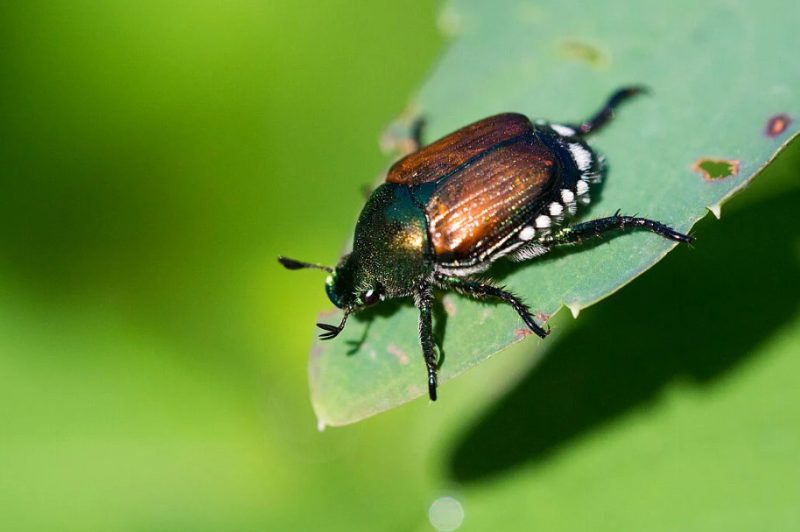
The Japanese Beetle is a small, metallic-green insect with bronze-colored wing covers and white tufts along its abdomen. Measuring about 0.4 inches in length, it is one of the most recognizable garden pests in Indiana due to its bright iridescent sheen and feeding behavior.
These beetles emerge in midsummer and congregate in large numbers on plants. They feed on over 300 species of vegetation, including roses, grapes, and fruit trees. The grubs develop underground, feeding on grass roots, which damages lawns and turf.
Although Japanese Beetles do not bite or sting, their infestations can devastate gardens and crops. Adult beetles skeletonize leaves, leaving behind only the veins. Their presence attracts more beetles through pheromones, quickly worsening the problem.
In Indiana, control methods include hand-picking beetles early in the morning, using pheromone traps strategically, and maintaining healthy soil to discourage grubs. Natural predators like birds and parasitic wasps also help keep populations in check.
Wheel Bug (Arilus cristatus)
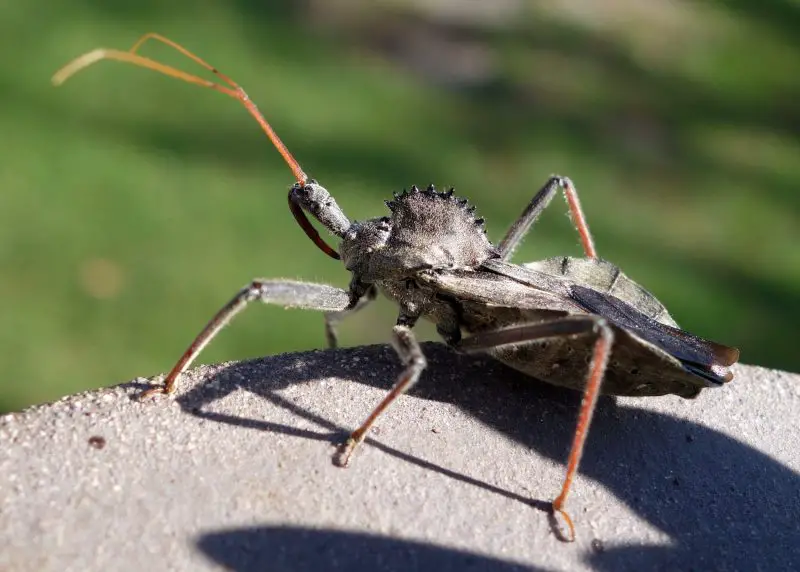
The Wheel Bug is one of the largest and most fascinating predatory insects found in Indiana. It can reach up to 1.5 inches long and is easily recognized by the distinctive, cog-like “wheel” structure on its thorax. Its grayish-brown, armored body and long curved beak give it a prehistoric appearance.
Wheel Bugs are solitary hunters that prey on caterpillars, beetles, and other pest insects. They are often spotted on trees, gardens, and lights at night during late summer and fall. Despite their slow movements, they are efficient predators that deliver a swift paralyzing bite to their prey.
Although beneficial, Wheel Bugs can inflict a painful bite if handled. Their bite is not venomous but can cause swelling, numbness, and lingering pain lasting several days. They are not aggressive but should never be touched with bare hands.
In Indiana, Wheel Bugs play an important ecological role in controlling harmful insect populations. They prefer habitats with abundant prey and minimal disturbance. Observing them from a distance allows residents to appreciate their usefulness without risking an unpleasant bite.
Stink Bug (Halyomorpha halys)
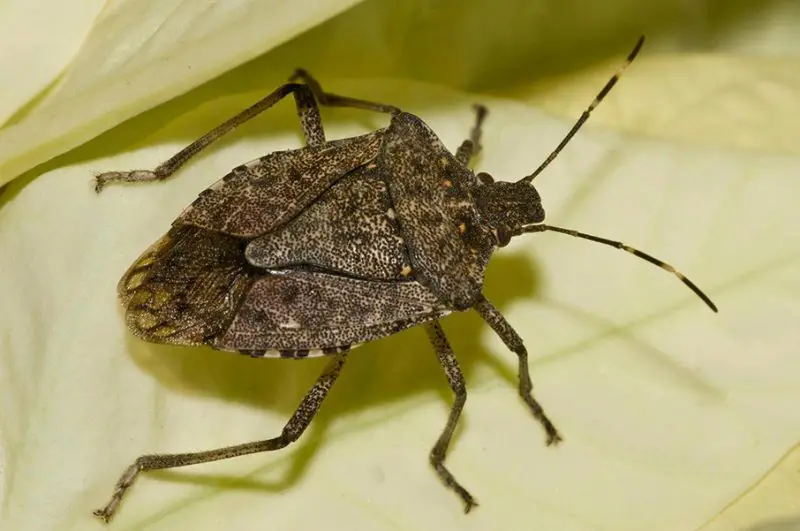
The Stink Bug, specifically the Brown Marmorated Stink Bug, is a shield-shaped insect about 0.6 inches long, with mottled brown and gray coloring. It has distinct light and dark banding on its antennae and edges of the abdomen. This invasive species, native to Asia, has spread widely throughout Indiana, especially in agricultural and residential areas.
These bugs feed on fruits, vegetables, and ornamental plants by piercing them with their needle-like mouthparts and sucking out juices. They are most active in late summer and fall when they seek warmth and may enter homes to overwinter. Indoors, they become a nuisance more than a health hazard.
True to their name, Stink Bugs emit a pungent odor when crushed or threatened. The smell, produced from scent glands, deters predators but can linger in homes and on hands. While they do not bite or sting, their presence can trigger mild allergic reactions in sensitive individuals.
In Indiana, sealing windows, doors, and foundation cracks is the best prevention. Vacuuming instead of crushing them avoids spreading the smell. Natural predators like birds and parasitic wasps help control their populations outdoors.
Giant Water Bug (Lethocerus americanus)
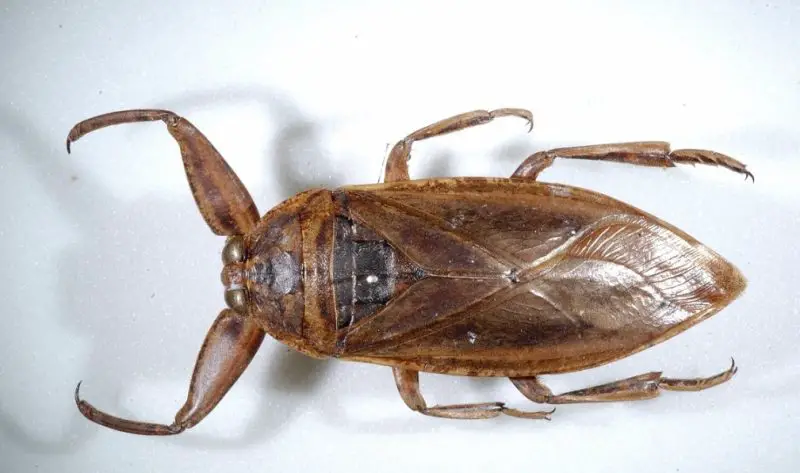
The Giant Water Bug, sometimes called a “toe biter,” is one of Indiana’s largest aquatic insects, reaching up to 2.5 inches long. It has a flat, oval brown body with strong, grasping forelegs adapted for catching prey and short wings covering its back. These bugs are powerful swimmers that live in ponds, lakes, and slow-moving streams.
They are fierce predators that feed on fish, tadpoles, and aquatic insects. Using their sharp beak, they inject digestive enzymes into prey and then suck out the liquefied contents. Giant Water Bugs are most often seen during warm months, sometimes flying to lights at night.
Their bite, though rare, is extremely painful and considered one of the most intense among insects in Indiana. The bite causes swelling and burning but is not venomous or medically dangerous. These insects do not attack unless handled or stepped on.
Giant Water Bugs are ecologically important, helping regulate aquatic populations. In Indiana, it’s best to admire them from a distance when encountered near water. Avoid grabbing them bare-handed to prevent painful bites.
Fire Ant (Solenopsis invicta)
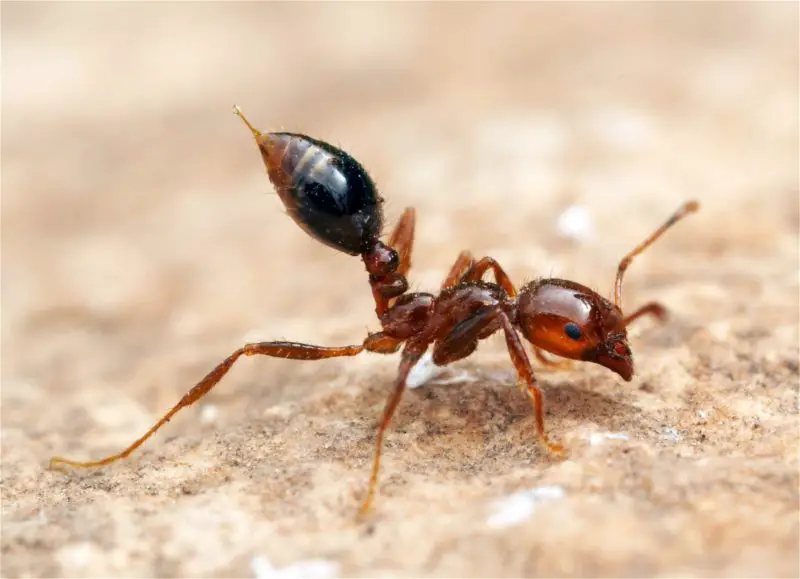
Fire Ants are reddish-brown ants about 0.1 to 0.25 inches long with darker abdomens. Although native to South America, they have occasionally been introduced to Indiana through transported soil or nursery plants. Colonies are aggressive and can contain thousands of individuals forming large mounds in open, sunny areas.
These ants are highly territorial and sting repeatedly when their nest is disturbed. The sting injects alkaloid venom that causes burning, itching, and the formation of white pustules. In allergic individuals, multiple stings can trigger severe reactions such as anaphylaxis.
While Fire Ant populations are not well-established in Indiana’s colder climate, occasional infestations have been reported in the southern parts of the state. Their mounds can damage electrical equipment and harm wildlife. Immediate control is important when colonies are discovered.
Professional pest control and bait treatments are recommended for managing Fire Ants. Wearing boots and tucking in clothing when outdoors in infested areas can prevent bites. Residents should report suspected infestations to local agricultural authorities to prevent spread.
Velvet Ant “Cow Killer” (Dasymutilla occidentalis)
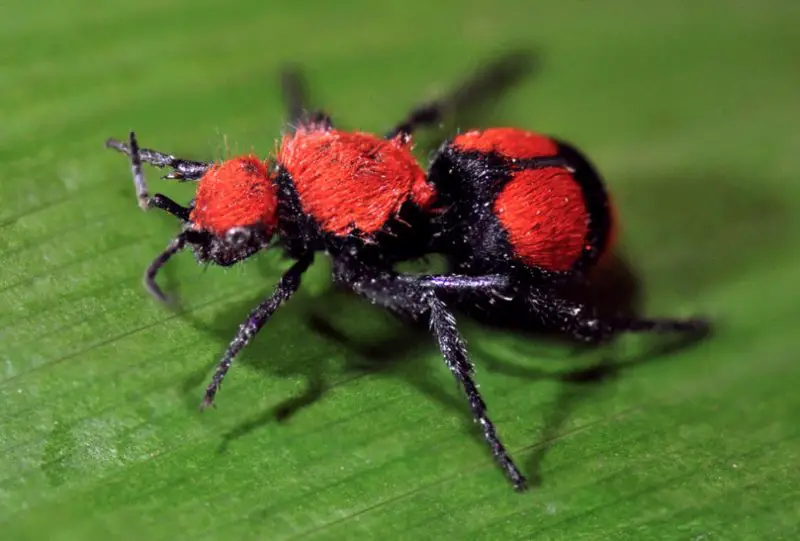
The Velvet Ant, commonly called the “Cow Killer,” is actually a wingless female wasp, not a true ant. It is brightly colored with a fuzzy red-orange and black body measuring about 0.75 inches long. Its striking appearance serves as a warning of its powerful sting.
These insects are found in sandy or open habitats across southern Indiana, especially in fields, paths, and forest edges. Females wander on the ground searching for the nests of ground-nesting bees or wasps, where they lay eggs. The larvae then develop as parasites on the host pupae.
The sting of a Cow Killer is extremely painful, reportedly strong enough to make large animals react violently—hence the name. However, they are not aggressive and only sting when stepped on or handled. Their venom is not deadly but causes intense, lasting pain.
In Indiana, Cow Killers play an ecological role by regulating other insect populations. Observing them from a distance is safe, as they do not bite or swarm. Their vivid coloration alone is enough to remind most people to keep their distance.
Horsefly (Tabanus species)
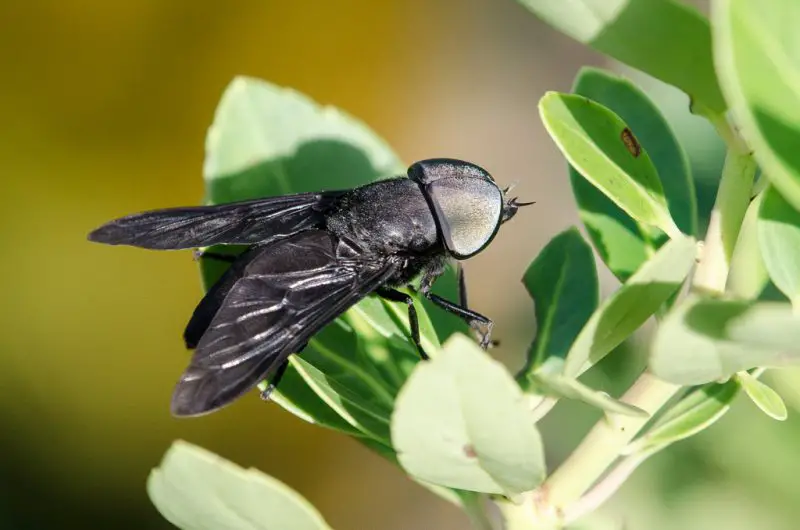
Horseflies are large, fast-flying insects measuring 0.5 to 1 inch in length. They have broad heads, large iridescent eyes, and gray or black bodies. Females are the ones that bite, using sharp mouthparts to slice skin and feed on blood, while males feed on nectar.
In Indiana, Horseflies are common near lakes, rivers, and farmlands during summer. They are attracted to movement, dark colors, and carbon dioxide from animals and humans. Their bite is painful and often accompanied by immediate swelling and itching.
While Horsefly bites are not venomous, they can cause allergic reactions or secondary infections if scratched. The flies can also transmit diseases to livestock, though human infection is rare. Their persistence makes them one of the most bothersome summer pests.
To reduce encounters in Indiana, avoid wearing dark clothing near water and use repellents containing DEET. Installing fans in outdoor spaces can also deter these strong fliers. Their bite may be painful, but Horseflies rarely pose serious health threats.
Deer Fly (Chrysops species)
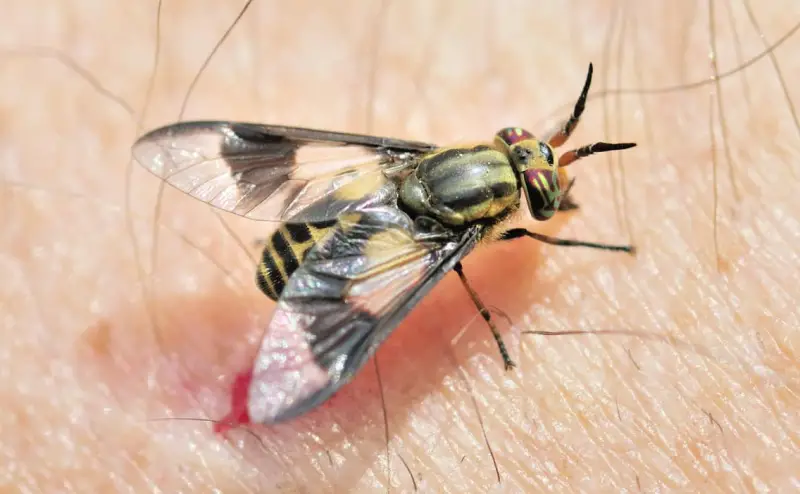
Deer Flies are smaller relatives of Horseflies, measuring around 0.25 to 0.4 inches long. They are easily recognized by their patterned wings and brightly colored, iridescent eyes. Females feed on blood, while males consume nectar and plant juices.
These flies thrive in Indiana’s wetlands, forest edges, and shaded trails during late spring and summer. They are active during the day, often circling around heads and shoulders of humans or animals before biting. Their bites are sharp, painful, and can bleed freely.
Deer Fly bites may cause itching, swelling, and redness. While they do not typically transmit disease in Indiana, their bites can lead to irritation or infection if not cleaned properly. Their aggressive behavior and persistence make them a serious outdoor nuisance.
Preventive measures include wearing light-colored clothing, applying insect repellents, and avoiding heavily wooded areas during peak activity times. Deer Flies are drawn to motion and dark colors, so slowing movements and staying in breezy areas can reduce bites.
Bed Bug (Cimex lectularius)
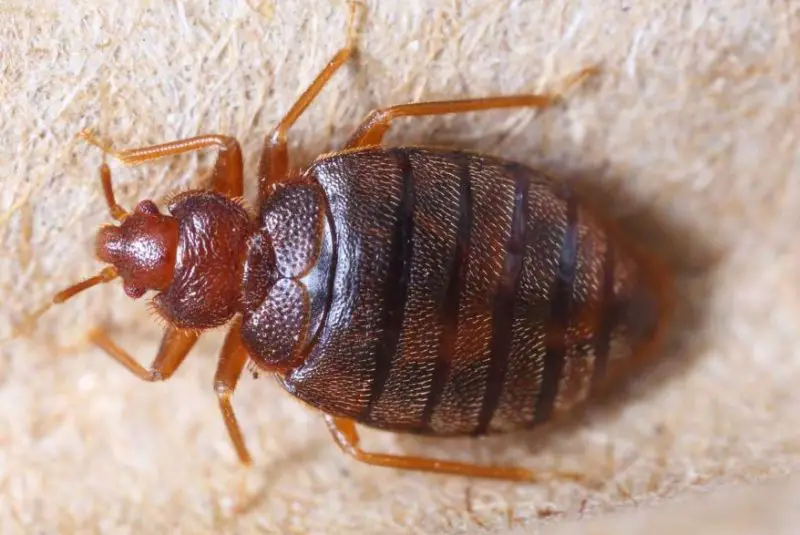
Bed Bugs are small, flat, reddish-brown insects that measure about 0.2 inches long. They have oval bodies and no wings, feeding exclusively on the blood of humans and warm-blooded animals. These nocturnal insects hide in mattresses, furniture seams, and wall cracks during the day.
Bed Bugs are found throughout Indiana, especially in hotels, apartments, and dormitories where people live in close quarters. They travel easily on luggage, clothing, and used furniture, allowing infestations to spread quickly between locations.
Their bites are not painful at first but later develop into red, itchy welts, often arranged in a line or cluster. Although they do not transmit diseases, the irritation can lead to scratching and secondary infections. Persistent infestations can cause stress and insomnia.
Controlling Bed Bugs requires thorough cleaning, vacuuming, and professional heat treatments. Washing bedding in hot water and sealing infested furniture helps reduce populations. In Indiana, Bed Bugs are among the most challenging pests to eradicate once they establish indoors.
Tips for Preventing and Managing Dangerous Bugs in Indiana
Keeping bugs at bay in Indiana requires a mix of awareness, prevention, and safe handling. While most insects play valuable ecological roles, some can bite, sting, or spread disease. These tips will help you stay safe and minimize encounters.
Seal Entry Points and Eliminate Hiding Spots
Inspect your home regularly for cracks around doors, windows, and foundations. Use caulk or weather stripping to close small gaps where spiders, ticks, or stink bugs might enter. Keep attics, basements, and storage spaces clean and clutter-free to reduce hiding areas for insects such as Brown Recluse Spiders and Bed Bugs.
Reduce Standing Water and Moisture
Mosquitoes and many other pests breed in stagnant water. Empty birdbaths, buckets, and flowerpot trays weekly. Maintain gutters and drains to prevent pooling water. Inside the home, fix leaky faucets and pipes to discourage moisture-loving pests like mosquitoes and stink bugs.
Protect Yourself Outdoors
When hiking or working in tall grass, wear long sleeves, pants, and closed shoes to deter ticks and biting flies. Use insect repellents containing DEET or picaridin. Avoid using scented lotions or perfumes, which can attract wasps and hornets. For those allergic to stings, carrying an epinephrine injector is a wise precaution.
Handle Nests and Infestations Safely
Never attempt to remove hornet or wasp nests without professional help, especially if they’re large or close to your home. For indoor infestations like Bed Bugs or Carpenter Bees, contact pest control specialists for safe and effective treatment. Avoid crushing Stink Bugs or Blister Beetles, as they release unpleasant odors or skin-irritating chemicals.
FAQs about Dangerous Bugs in Indiana
Are there venomous bugs in Indiana?
Yes. Indiana is home to venomous species such as the Brown Recluse Spider and the Black Widow Spider. Both can deliver medically significant bites that require prompt attention. While their bites are rarely fatal, seeking medical care is essential if symptoms like spreading redness, fever, or ulceration occur.
Which insects in Indiana are most likely to sting?
Stinging insects include Yellowjackets, Bald-Faced Hornets, Paper Wasps, and Velvet Ants (Cow Killers). These species sting defensively when threatened or when their nests are disturbed. Their stings can cause severe pain, swelling, or allergic reactions in sensitive individuals.
Do any bugs in Indiana spread diseases?
Yes. Deer Ticks can transmit Lyme disease, while Culex mosquitoes are known carriers of the West Nile virus. Although rare, some biting insects like Assassin Bugs have been associated with disease transmission in other regions. Preventing bites and checking your body after outdoor activities are the best safeguards.
What should I do if bitten or stung by a bug?
First, wash the affected area with soap and water. Apply a cold compress to reduce pain and swelling. Over-the-counter antihistamines can help relieve itching. If you experience difficulty breathing, dizziness, or swelling of the face or throat, seek emergency medical care immediately.
How can I tell if there’s a dangerous infestation at home?
Signs include multiple bug sightings, strange odors, shed skins, or small bite marks on the body. Stink Bugs tend to cluster around windows, Bed Bugs leave reddish stains on sheets, and Carpenter Bees bore small, round holes in wood. Early detection and professional inspection can prevent serious infestations.
Are bug bites and stings dangerous to pets?
Yes. Pets can suffer from allergic reactions or infections from bites and stings. Ticks may transmit diseases such as ehrlichiosis or Lyme disease to dogs. Keep pets on veterinarian-approved flea and tick preventives and inspect their fur regularly after outdoor activity.
What time of year are bugs most active in Indiana?
Most biting and stinging insects are active from late spring through early fall, when temperatures are warm and humidity is high. Mosquitoes, ticks, and wasps reach peak activity during the summer, while Stink Bugs and spiders become more noticeable in autumn as they seek shelter indoors.
Can natural remedies help control bugs?
Some natural methods, such as planting lavender, citronella, or marigolds, can deter mosquitoes and certain insects. Diatomaceous earth is also effective for crawling pests. However, for serious infestations, professional pest management remains the safest and most reliable solution.

